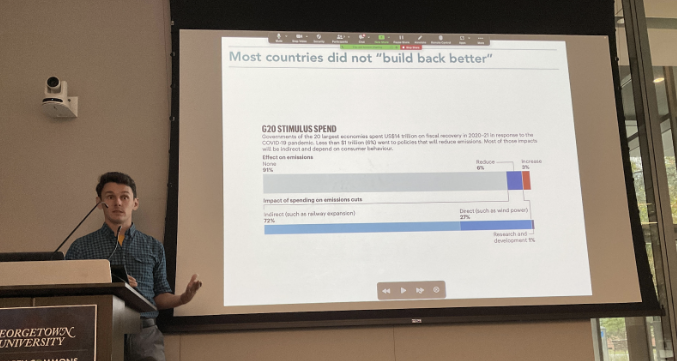Scot Miller, an assistant professor at the department of environmental health and engineering at Johns Hopkins, discussed how scientists use atmospheric observations from satellites and telecommunications towers to monitor greenhouse gas production in an Oct. 6 “ECo Talk,” a lecture series about environmental science hosted by Georgetown’s Earth Commons Institute.
The pressing need to utilize environmental science research to fuel policy change that limits greenhouse gas emissions motivated Miller’s talk, “Three Case Studies in Greenhouse Gas Emissions – new insights provided by an expanded atmospheric observing network.”
Greenhouse gasses (GHG), which raise the surface temperature of the Earth, are continuing to grow at historically high rates due to human activities like cutting down forests and burning coal, according to a 2022 study published in “Atmospheric Chemistry and Physics.”
Miller said climate change is impacting certain parts of the globe more than others, so it is imperative that the countries contributing the most to the production of GHG, including China, the United States and India, reduce their emissions sooner rather than later.
“I think scientists and regulators really need a way to hold countries or states or municipalities to account for their greenhouse gas emissions,” Miller said at the event.
One way to do this is through data collection from recently implemented satellites or monitors on top of telecommunications towers around the globe, according to Miller. These measurements — which are not direct observations of GHG as they are being generated, but rather detect the amount accumulating in the atmosphere — can be used to deduce where the emissions are coming from.
“We’re seeing signals from these big super-emitters in the observations that we collect from these satellites,” Miller said. “When we started to have millions of observations from these satellites, we could start to pick out the location of these super-emitters.”
Miller presented three case studies that feature applications of the latest GHG-monitoring technology, the first of which focused on California’s emissions. A gas called sulfuryl fluoride, which is commonly used to fumigate termites, has been discovered as an unexpected GHG, as it sticks around in the atmosphere for 36 years before breaking down.
Because sulfuryl fluoride’s usage in California is equivalent to double the state’s average annual GHG emissions in recent years, the use of this gas has significantly contributed to the state’s GHG emissions.
Miller said it is possible to mitigate these emissions by capturing and re-using sulfuryl fluoride, destroying it by bubbling the gas through certain solutions or switching to an alternative termite-killer like orange oil.
The second case study he presented used satellite observations to examine China’s methane emissions. China, the world’s largest methane emitter, produces the gas during coal mining to use for electricity production. Miller said he and his research group use satellite and surface observations of methane emissions to assess the effectiveness of regulations at lowering methane production. Because China’s methane output was still increasing by about 1.1 teragrams per year five years after they implemented regulations surrounding methane emissions, Miller’s group concluded that these policies do not have a detectable impact on reducing methane output.

Miller ended the talk by presenting a final case study on how satellite observations are used to detect changes in atmospheric carbon dioxide levels. As plants take up carbon dioxide in the summer and release the gas in the winter, there is a natural flux in the amount of carbon dioxide gas in the atmosphere, according to Miller.
However, Miller discussed how climate change will likely disturb this biospheric carbon cycle: more carbon dioxide will be taken up in the summer and more will be released in the winter, altering the regular growing schedule of plants due to the amount of carbon dioxide they will be intaking and releasing.
“The seasonal phase could change, meaning trees could start leafing out earlier in the year and hold their leaves later in the year so we could see a broadening of the seasonal cycle, ” Miller said.
Miller’s presentation was part of the weekly ECo Talk lecture series about environmental science that encourages an exchange of diverse perspectives about environmental research, according to Oswaldo Villena, a postdoctoral fellow at the Earth Commons.
“This series enriches my way of seeing things and thinking how I can apply what I learn into my own research,” Villena told The Hoya. “For instance, I didn’t know the existence of a Japanese satellite that Dr. Miller mentioned in his talk, and I think I will see if I can input this data into my own research.”








